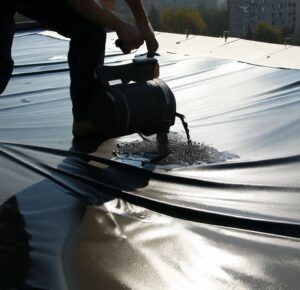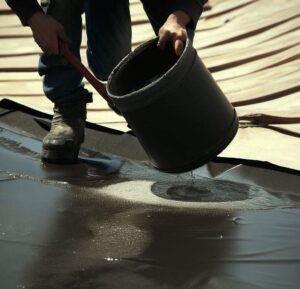The Cost of Water Damage
Water intrusion, whether from a sudden flooding event or a persistent damp spot, presents a damaging force that can wreak havoc on both the interior and exterior of your property. When water invades your property, the repercussions are far more serious than a mere dampening of spirits. The damage can range from seemingly innocent superficial nuisances such as staining, discolouration and unpleasant damp odors, to significantly more severe problems like the growth of harmful mold, timber decay, and even structural compromise.
Obvious issues like visual water stains or damp spots are often just the tip of the iceberg. Hidden moisture can lead to mold growth, which poses hazardous health risks to occupants, including respiratory problems, allergenic reactions, and in severe cases, toxic responses. Beyond these health hazards, mold remediation can also be a costly operation, requiring professional intervention for thorough removal and prevention.
Structural damage is another critical effect of water intrusion. Constant exposure to moisture can cause wood to rot, concrete to weaken, and metal to rust, seriously impacting the structural integrity of your property. This damage can lead to expensive and extensive repairs, and in severe cases, could even necessitate a partial or total building reconstruction.
This all adds up to significant financial burden. According to HomeAdvisor, homeowners pay an average of $2,597 for water damage repair, but this can quickly escalate depending on the severity of the damage and the extent of repairs required. In worst-case scenarios, costs can soar into the tens of thousands as water damage can impact electrical systems, foundations, and even lead to a total loss of property.
To put it in context, Property Casualty 360 estimates the average flood insurance claim amount between 2006 and 2015 was $42,580. Even a small amount of water can lead to massive restoration costs, not to mention the extra costs associated with displacement during repair, potential increases in insurance premiums, and possible reduction in property value after a marked water damage incident.
The financial implications of water damage can be staggering, reaching far beyond the immediately apparent physical damage and emphasizing the importance of proactive water damage prevention measures, such as quality waterproofing.
Understanding Waterproofing

Quality waterproofing is an indispensable technique in property maintenance, aimed at effectively sealing and fortifying properties against hazardous water intrusion. By creating a barrier between the exterior elements and the interior of your building, waterproofing serves as an exceptionally effective preventative measure against the detrimental effects of excess water exposure.
A common misperception about waterproofing is that it involves slapping a layer of material over a problem area and calling it a day. In reality, the process is much more thorough and detail-oriented. Quality waterproofing involves an in-depth evaluation of the property to identify potential risk areas for water entry, as well as the root causes of any existing water or dampness issues. Once these areas are identified, a tailored waterproofing solution using high-grade durable materials is applied to effectively prevent water seepage and accumulation.
These high-grade materials may include a variety of waterproofing membranes, sealants, and coatings, specifically engineered to withstand environmental factors and provide long-term water prevention. The choice of materials used would largely depend on the nature of the building, its construction, the kind of water exposure it faces, and other surrounding factors.
Waterproofing does not merely shield your property from water intrusion, but it also maintains a dry, mold-free, and structurally sound environment by stopping excess moisture from entering the building. In a well-waterproofed property, the integrity of the foundation and structural elements are maintained, preventing issues like mold growth, wood rot and concrete spalling. This gives a long, healthy life to your property, and provides a safe and secure environment for its occupants.
Quality waterproofing goes beyond offering protection from water damage. It also extends to improving overall building health and indoor air quality, enhancing the comfort and wellbeing of occupants. By preventing excess humidity and deterring the growth of mold, waterproofing contributes to creating a healthier, more comfortable space for living or work.
Cost-Benefit Analysis of Waterproofing
 Looking at the figures, the financial investment in quality waterproofing becomes an easily justifiable expense. On the surface, the initial outlay for waterproofing your property can seem like a significant cost, but if viewed accurately as a long-term investment in the protection, preservation and improvement of your property, the benefits become obvious.
Looking at the figures, the financial investment in quality waterproofing becomes an easily justifiable expense. On the surface, the initial outlay for waterproofing your property can seem like a significant cost, but if viewed accurately as a long-term investment in the protection, preservation and improvement of your property, the benefits become obvious.
A primary economic advantage of waterproofing is the resultant decrease in maintenance and repair expenditures. By effectively impeding water damage at the source, the need for frequent and often costly repairs associated with water damage is significantly reduced, if not eliminated. Over time, the savings from these avoided costs can be substantial, reducing overall expenditure on home maintenance.
There’s considerable value to be found in the potential increase in property value. Prospective buyers often assess properties with a keen eye on the structural upkeep, and a property that has been duly waterproofed presents a solid investment. A waterproofed property is indicative of a proactive, cautious owner and suggests the rest of the property has been similarly well maintained, which could command a higher price point in the property market.
The even less considered, yet remarkably noteworthy aspect of the cost-benefit balance of waterproofing rests in its potential contribution to energy savings. By creating an effective barrier against exterior elements, waterproofing can enhance a building’s insulation. This function is twofold: it maintains a more consistent internal temperature, reducing the need for heating in the winter and cooling in the summer, and prevents dampness, which can reduce the effectiveness of insulation. The subsequent decrease in energy usage can translate into significant savings on utility bills over the long term.
The cost-benefit analysis of waterproofing lends itself strongly in favor of the initial investment. The upfront payment more than justifies itself through the combined financial savings – direct savings through reduced maintenance and repair, increased property value, and the augmented energy efficiency leading to lower utility costs. This all then must be weighed against the potential staggering costs of water damage repair, making a clear case for the value of a quality waterproofing investment.
Investing in quality waterproofing holds remarkable economic benefits. While the upfront cost may seem intimidating, the long-term financial savings make waterproofing a smart investment. From staving off costly repairs to boosting property value and energy savings, waterproofing is truly worth considering for your properties.